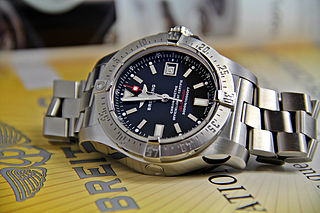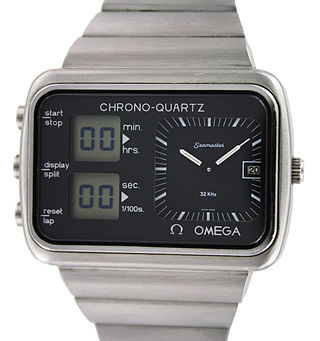
A watch is a portable timepiece intended to be carried or worn by a person. It is designed to keep a consistent movement despite the motions caused by the person's activities. A wristwatch is designed to be worn around the wrist, attached by a watch strap or other type of bracelet, including metal bands, leather straps, or any other kind of bracelet. A pocket watch is designed for a person to carry in a pocket, often attached to a chain.

Breitling SA is a Swiss luxury watchmaker founded in 1884 in Saint-Imier, Switzerland, by Léon Breitling. The company is known for its precision-made chronometers designed for aviators and is based in Grenchen, Switzerland.

Omega SA is a Swiss luxury watchmaker based in Biel/Bienne, Switzerland. Founded by Louis Brandt in La Chaux-de-Fonds in 1848, the company formerly operated as La Generale Watch Co. until incorporating the name Omega in 1903, becoming Louis Brandt et Frère-Omega Watch & Co. In 1984, the company officially changed its name to Omega SA and opened its museum in Biel/Bienne to the public. Omega is a subsidiary of The Swatch Group.

The Contrôle officiel suisse des Chronomètres (COSC), the Official Swiss Chronometer Testing Institute, is the institute responsible for certifying the accuracy and precision of Swiss watches.

A chronograph is a specific type of watch that is used as a stopwatch combined with a display watch. A basic chronograph has an independent sweep second hand and a minute sub-dial; it can be started, stopped, and returned to zero by successive pressure on the stem. More complex chronographs use additional complications and can have multiple sub-dials to measure seconds, minutes, hours and even fractions of a second. In addition, many modern chronographs use moveable bezels as tachymeters for rapid calculations of speed or distance. Louis Moinet invented the chronograph in 1816 for use in tracking astronomical objects. Chronographs were also used heavily in artillery fire in the mid to late 1800s. More modern uses of chronographs involve aircraft piloting, auto racing, diving and submarine maneuvering.

Swatch is a Swiss watchmaker founded in 1983 by Ernst Thomke, Elmar Mock, and Jacques Müller. It is a subsidiary of The Swatch Group. The Swatch product line was developed as a response to the "quartz crisis" of the 1970s and 1980s, in which inexpensive, battery-powered, quartz-regulated watches were competing against more established European watchmakers, focused on artisanal craftsmanship producing mostly mechanical watches.

ETA SA Manufacture Horlogère Suisse designs and manufactures quartz watches and both hand-wound and automatic-winding mechanical ébauches and movements. Commonly referred to as ETA, the company is headquartered in Grenchen, Switzerland, and is a wholly owned subsidiary of The Swatch Group.

Zeno-Watch is a Swiss watchmaker established in 1868, though the Zeno name has been in use only since 1922. They are an entry-level Swiss brand, using and ETA movement for their mechanical watches. Specializing in aviation watches, they are one of the few independent Swiss watch manufacturers still in operation. The factory is based in Basel, Switzerland.

Omega Speedmaster is a line of chronograph wristwatches produced by Omega SA. While chronographs have existed since the late 1800s, Omega first introduced this line of chronographs in 1957. Since then, many different chronograph movements have been marketed under the Speedmaster name. Astronaut Walter Schirra was the first person to wear one in space in 1962 during his Mercury-Atlas 8 mission. The manual winding Speedmaster Professional or "Moonwatch" is the best-known and longest-produced; it was worn during the first American spacewalk as part of NASA's Gemini 4 mission, and was the first watch worn by an astronaut walking on the Moon during the Apollo 11 mission. The Speedmaster Professional remains one of several watches qualified by NASA for spaceflight, and is still the only one so qualified for EVA. The Speedmaster line also includes other models, including analog-digital and automatic mechanical watches.

The coaxial escapement is a type of modern watch escapement mechanism invented by English watchmaker George Daniels in 1976 and patented in 1980. It is one of the few watch escapements to be invented in modern times and is used in most of the mechanical watch models currently produced by Omega SA.

The Rolex Oyster Perpetual Submariner is a line of sports watches designed for diving and manufactured by Rolex, resistant to water and corrosion. The first Submariner was introduced to the public in 1954 at the Basel Watch Fair. It was the first watch to be waterproof up to 100 metres (330 ft). The Rolex Submariner is considered "a classic among wristwatches", manufactured by one of the most widely recognized luxury brands in the world. Due to its huge popularity, there are many homage watches by well-established watchmakers, as well as illegal counterfeits. The Rolex Submariner is part of Rolex's Professional line.
Anti-magnetic (non-magnetic) watches are those that are able to run with minimal deviation when exposed to a certain level of magnetic field. The International Organization for Standardization issued a standard for magnetic-resistant watches, which many countries have adopted.
A helium release valve, helium escape valve or gas escape valve is a feature found on some diving watches intended for saturation diving using helium based breathing gas.

A diving watch, also commonly referred to as a diver's or dive watch, is a watch designed for underwater diving that features, as a minimum, a water resistance greater than 1.1 MPa (11 atm), the equivalent of 100 m (330 ft). The typical diver's watch will have a water resistance of around 200 to 300 m, though modern technology allows the creation of diving watches that can go much deeper. A true contemporary diver's watch is in accordance with the ISO 6425 standard, which defines test standards and features for watches suitable for diving with underwater breathing apparatus in depths of 100 m (330 ft) or more. Watches conforming to ISO 6425 are marked with the word DIVER'S to distinguish ISO 6425 conformant diving watches from watches that might not be suitable for actual scuba diving.

A chronometer is an extraordinarily accurate mechanical timepiece, with an original focus on the needs of maritime navigation. In Switzerland, timepieces certified by the Contrôle Officiel Suisse des Chronomètres (COSC) may be marked as Certified Chronometer or Officially Certified Chronometer. Outside Switzerland, equivalent bodies, such as the Japan Chronometer Inspection Institute, have in the past certified timepieces to similar standards, although use of the term has not always been strictly controlled.

The Omega Seamaster 200 Omegamatic is a midsize automatic quartz watch that Omega produced from 1997 until 2000. It has stainless steel case and bracelet, screw-in crown and caseback, engraved with the Omega Hippocamp logo, 200 meters water resistant, unidirectional bezel, silver or black dial with orange accents, sapphire crystal (anti-reflective) with magnifying (cyclops) date window, case diameter 36mm, 2.4V capacitor, rotor charging micro generator, quartz controlled stepper motor and quickset date function.

The Omega Chrono-Quartz was the world's first digital/analogue chronograph. It was invented by Omega SA. The watch launched at the 1976 Montreal Olympic Games and was Omega's flagship chronograph at that time. The watch is noteworthy as it was the first chronograph wristwatch in the world to combine analogue display for the time functions and a digital display for the chronograph function, each working independently of one another but running on the same quartz resonator. (32 kHz)

The Omega Bullhead was introduced in 1969 as part of the Chronostop range, it was marketed as drivers / rally watch and was nicknamed the "Bullhead" because of the configuration of the winding crown being located at 12 o'clock with the chronograph pushers on either side.

Montres Tudor SA, or simply Tudor, is a Swiss watchmaker based in Geneva, Switzerland. Registered in 1926 by Hans Wilsdorf, founder of Rolex, the brand remains a sister company to Rolex; both companies are owned by the Hans Wilsdorf Foundation. Tudor was initially known for watches produced for the military and professional divers. From the 1960s to 1980s, several navies issued Tudor Submariners to their divers, including the US Navy SEALs and the French Marine Nationale.


![Omega Seamaster (1960). Champagne dial, [?] 35mm, small seconds. Omega Seamaster ca. 1960.jpg](http://upload.wikimedia.org/wikipedia/commons/thumb/9/96/Omega_Seamaster_ca._1960.jpg/220px-Omega_Seamaster_ca._1960.jpg)



















